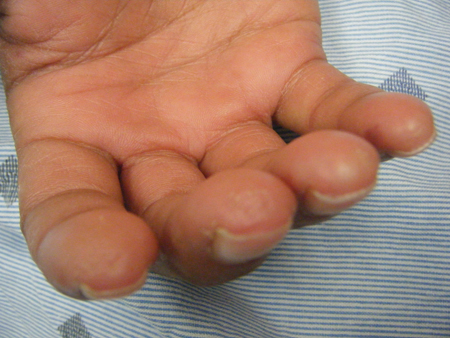Case history
Case history #1
A 38-year-old woman presents with Raynaud phenomenon for the past 5 years. She also has a history of digital ulcers and GERD. Physical exam reveals telangiectasias on the hands. She has sclerodactyly. Digital pits are present with no active ulcers. Serology tests reveal a high-titer antinuclear antibody (ANA) by indirect immunofluorescence, at a titer of >1:640 in a centromere pattern. The patient is diagnosed with limited cutaneous systemic sclerosis.[Figure caption and citation for the preceding image starts]: Digital pits without ulcersFrom the collection of Maureen D. Mayes, University of Texas [Citation ends].
Case history #2
A 35-year-old woman presents complaining of puffy hands and feet for the past 3 months. She noted the onset of Raynaud phenomenon 6 months ago. Examination confirms the presence of puffy hands and feet, with subtle skin thickening of the fingers and dorsum of the hands. Serology tests reveal a positive ANA with both speckled and nucleolar patterns at a titer of >1:1280. Anti-topoisomerase (anti-Scl 70) antibody is strongly positive. Pulmonary function tests are normal (although this does not preclude the possibility of the development of fibrosis at a later date). The patient is diagnosed with diffuse cutaneous systemic sclerosis.
Other presentations
On rare occasions, patients can present with scleroderma renal crisis, consisting of accelerated hypertension, renal compromise, and microangiopathic hemolytic anemia. Raynaud phenomenon and sclerodactyly may be present but overlooked by the patient and therefore not previously brought to medical attention.
Use of this content is subject to our disclaimer